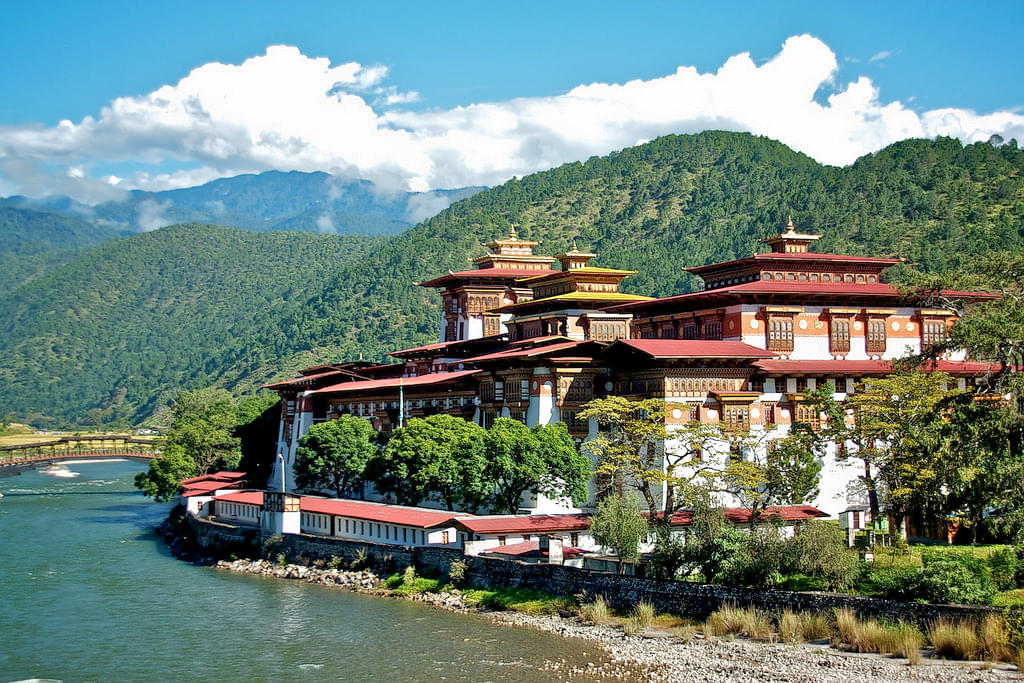About Punakha Dzong
It is also the second oldest and second largest dzong in Bhutan. It is famous for showcasing the fine craftsmanship of Bhutanese artisans. The location of the dzong offers breathtaking views, especially in the spring season. This is when you can see the bloom of the jacaranda trees, adding a splash of bright purple to the landscape.
The dzong also serves as a significant historical and religious centre. It houses many sacred relics of Tibetan Buddhism. It has also played a crucial role in Bhutan's history, serving as the main site of coronations and royal events. This is also where the royal wedding of King Jigme Khesar Namgyel Wangchuck and Jetsun Pema took place in 2011. Punakha Dzong's architecture features intricate woodwork, stunning murals, and a series of vast courtyards. These features reveal the depth of Bhutan's spiritual and cultural heritage. Its strategic position and the serene beauty of the valley also make it a must-visit for those touring Bhutan.
History Of Punakha Dzong
Constructed in 1637 by Ngawang Namgyal, Punakha Dzong, known as Pungtang Dechen Phodrang, holds significant historical importance in Bhutan. It served as the seat of government until 1955 and is still the winter residence of the central monastic body. The dzong played a pivotal role in Bhutanese history, hosting the coronation of the first King in 1907. Strategically located at the confluence of the Pho Chhu and Mo Chhu rivers, it facilitated defense against invasions. Despite natural disasters and reconstructions, the dzong retains its grandeur, serving as a cultural and spiritual symbol of Bhutan's rich heritage and tradition.
For a romantic escape, choose the perfect Bhutan Tour Package For Couple.
Punakha Dzong Highlights
• Admire Punakha Dzong's architecture, complete with white walls and detailed woodwork & explore the inner halls that house precious relics of Tibetan Buddhism and offer insights into the Buddhist culture.
• Take a moment to visit the serene courtyards and temples within the complex, experiencing the peaceful ambiance and spiritual significance.
• Join the vibrant Punakha Festival and experience Bhutanese culture through traditional dance performances and rituals.
• Marvel at the dzong's marvelous location, where the Pho Chhu and Mo Chhu rivers meet, enhancing its serene ambiance.
• Punakha Dzong, also known as Pungtang Dechen Phodrang Dzong, is one of the most iconic and significant dzongs in Bhutan
• Walking across the traditional cantilever bridge to enter the dzong provides a serene and picturesque experience.
How To Reach Punakha Dzong
By Bus: From Thimphu, take a local or state bus to Punakha Dzong. This journey covers 72.8 kilometers and takes 3 to 5 hours. Frequent services allow you to enjoy Bhutan's scenic routes comfortably.
By Car: For a more personalized and comfortable option, rent a private car from Thimphu. This route takes you through places like the Dochula Pass, covering a distance of 72.8 kilometers. Depending upon your rest stops, the journey takes 2 to 3 hours.
Planning a group trip to Bhutan? Explore Bhutan Group Tour Packages for a hassle-free experience.
Best Time To Visit Punakha Dzong
Punakha Dzong offers enchanting experiences throughout the year, each season bringing its own charm. In spring (March to May), the dzong is adorned with colorful blooms, creating a picturesque backdrop for exploration. Summer (June to August) brings lush greenery and occasional refreshing rains, perfect for those seeking a verdant escape. Autumn (September to November) showcases clear skies and pleasant temperatures, ideal for unhurried exploration. Winter (December to February) offers crisp air and a serene ambiance, with the dzong exuding a quiet majesty against the snow-capped mountains.
Planning a family vacation in Bhutan? Explore our exclusive Bhutan Family Tour Packages.
Tourism Board Alliances
Punakha Dzong FAQs
Why is Punakha Dzong famous?
Punakha Dzong, also known as Pungtang Dechen Phodrang, is renowned for its historical significance and stunning architecture in Bhutan. Built-in 1637, it served as the seat of government until 1955 and remains the winter residence of the central monastic body. The dzong's strategic location at the confluence of the Pho Chhu and Mo Chhu rivers, along with its role in hosting key events like royal coronations, contributes to its fame as a cultural and spiritual landmark.
What is inside the Punakha Dzong?
Inside Punakha Dzong, visitors can explore a wealth of cultural and religious treasures. The complex houses sacred relics, intricate murals depicting Buddhist teachings, and beautifully carved woodwork showcasing traditional Bhutanese craftsmanship. Temples dedicated to various deities provide spaces for prayer and contemplation, while courtyards adorned with colorful flags offer serene environments for reflection. Additionally, visitors may encounter monks engaged in prayer and rituals, providing insight into Bhutanese Buddhist traditions and daily life within the dzong.
Who built Punakha Dzong?
Punakha Dzong, also known as Pungtang Dechen Phodrang, was built in 1637 by Ngawang Namgyal, the founder of Bhutanese Buddhism. Ngawang Namgyal constructed the dzong to serve as the religious and administrative center of the Punakha region, establishing its enduring significance in Bhutanese history and culture.
Are 2 days enough for Bhutan?
While Bhutan can be explored in two days, it's advisable to spend more time to fully appreciate its beauty and culture. Two days may allow you to visit major attractions like Thimphu and Paro, but extending your stay will provide a richer experience of Bhutan's diverse landscapes and cultural heritage.
What are the different types of Bhutan day & night tour packages that you can book with Thrillophilia?
Here are the different types of Bhutan day & night tour packages that you can book with Thrillophilia:
What are the best Bhutan tour packages that you can book with Thrillophilia?
Here are the best Bhutan tour packages that you can book with Thrillophilia:







